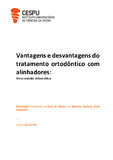| dc.contributor.advisor | GONÇALVES, ALINE DOS SANTOS | |
| dc.contributor.advisor | MONTEIRO, FRANCISCA MACHADO | |
| dc.contributor.author | Durand, Hugo Philippe Marc Aurele | |
| dc.date.accessioned | 2023-11-16T09:39:13Z | |
| dc.date.available | 2023-11-16T09:39:13Z | |
| dc.date.issued | 2023 | |
| dc.identifier.uri | http://hdl.handle.net/20.500.11816/4285 | |
| dc.description.abstract | Introdução: A ortodontia é uma especialidade da medicina dentária que se dedica ao diagnóstico, prevenção e tratamento das maloclusões dentárias e faciais. O movimento dentário ortodôntico pode ser promovido por aparelhos fixos ou removíveis (i.e., alinhadores). Cada vez mais se verifica que os pacientes procuram soluções de tratamento mais eficazes, com menos dor e o mais estéticas possível, de forma a reduzir impacto psicossocial do próprio tratamento ortodôntico.
Objetivos: Este trabalho visa comparar a utilização de alinhadores ortodônticos e aparelhos ortodônticos fixos e enumerar as vantagens e desvantagens de ambos os tratamentos.
Material e Métodos: A pesquisa foi realizada na base de dados Pubmed com as palavras-chaves pertinentes. Foram selecionados artigos publicados em inglês, incluindo estudos randomizados, retrospetivos, prospetivos e estudos case-control.
Resultados: Foram identificados 361 artigos, dos quais 15 foram selecionados para revisão. Os artigos selecionados mostram uma eficácia semelhante entre os aparelhos fixos e os alinhadores, mas a grande diferença foi encontrada relativamente ao tempo de duração, tendo-se verificado que os tratamentos com alinhadores demoram mais tempo.
Conclusão: A escolha entre alinhadores e aparelhos fixos deve ser baseada nas necessidades, preferências do paciente e na natureza do maloclusão a ser corrigida. O tratamento com alinhadores demora mais tempo, mas são preferidos pelos pacientes relativamente a estética e ao conforto. | pt_PT |
| dc.description.abstract | Introduction: Orthodontics is a specialty of dentistry that focuses on the diagnosis, prevention and treatment of dental and facial malocclusions. Orthodontic tooth movement can be promoted by fixed or removable applications (i.e., aligners). Patients have been increasingly seeking more effective treatment solutions, with less pain, and as aesthetic as possible, in order to reduce the psychosocial impact of the orthodontic treatment itself.
Objectives: This study aims to compare the use of orthodontic aligners and fixed orthodontic appliances and to list the advantages and disadvantages of both treatments.
Material and Methods: The search was conducted in the Pubmed database with the pertinent key terms. Articles published in English were selected, including randomized trials, prospective, retrospective and case-control clinical studies.
Results: A total of 361 articles were identified, of which 15 were selected for review. The selected articles show that a similar efficacy was observed between fixed devices and aligners, but significant differences was found regarding treatment duration; treatments with aligners are typically longer.
Conclusion: The choice between aligners and appliances should be based on the needs, preferences of the patient and the nature of the malocclusion to be corrected. The treatment with aligners takes longer, but they are preferred by patients in terms of aesthetics and comfort | pt_PT |
| dc.language.iso | por | pt_PT |
| dc.rights | info:eu-repo/semantics/openAccess | pt_PT |
| dc.subject | Aligners | pt_PT |
| dc.subject | Comparison | pt_PT |
| dc.subject | Fixed orthodontic appliances | pt_PT |
| dc.subject | Orthodontic movement | pt_PT |
| dc.subject | Removable orthodontic appliances | pt_PT |
| dc.title | Vantagens e desvantagens do tratamento ortodôntico com alinhadores: Uma revisão sistemática | pt_PT |
| dc.type | info:eu-repo/semantics/masterThesis | pt_PT |
| dc.identifier.tid | 203373308 | pt_PT |
| thesis.degree.name | Mestrado em Medicina Dentária | pt_PT |

